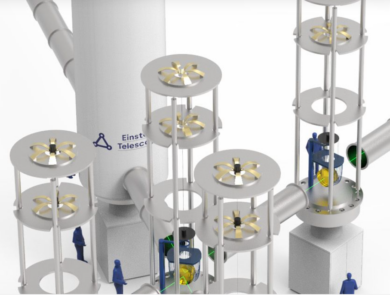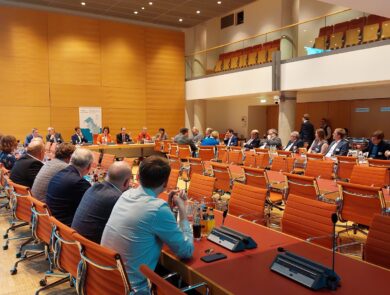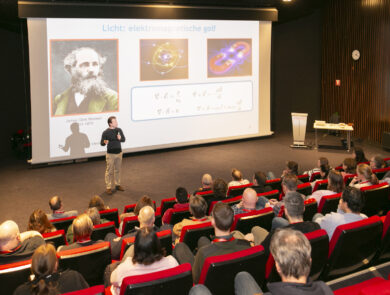Einstein Telescope prototype E-TEST passes its first series of tests
The E-TEST project demonstrates a technique that can cool the Einstein Telescope equipment close to absolute zero without touching it. That is an essential achievement to make the future gravitational wave observatory as noise-free as possible.
Part of the challenge of the Einstein Telescope is filtering out any possible type of vibration that could disturb its delicate measurements. Part of the answer is cooling down the device, without introducing any new noise from contact with the cooling equipment. The E-TEST project now demonstrates a cooling method that successfully brought a 100 kg test mass down to 22 degrees above absolute zero.

Developed in the laboratories of the University of Liège by Christophe Collette and his team, together with the thermo-mechanical team at the Liège Space Centre (CSL), the prototype Einstein telescope has undergone its first battery of tests in the CSL’s Focal 6.5 tank. The tests validated the cooling technology, the inverted pendulum principle and the ultra-sensitive vibration sensors. Encouraging results for this prototype for detecting gravitational waves, the only one of its kind in the world.
The Einstein telescope project has reached a new stage, with the E-TEST prototype – developed in the ULiège and CSL laboratories – being sent to the Liège Space Centre to undergo a battery of cryogenic and vibration tests. To function optimally, the future mirror of the Einstein telescope has to withstand being cooled to extreme temperatures and be subjected to almost no vibration.
“This was an important milestone for this unique and ambitious 4-year project, which began in 2020,” explains Christophe Collette, an engineer and scientific project coordinator at ULiège’s School of Engineering (Aerospace & Mechanical Engineering). “We suffered a few delays and setbacks due to the pandemic, access to materials and increased delivery times, but thanks to the team’s determination, we arrived with a finished prototype on time.”
Assembled at AMOS from August to October 2023, the E-TEST prototype was transferred to CSL at the beginning of November to be placed in the FOCAL 6.5 vacuum tank, which was used for the cooling tests. To avoid any risk of vibration, the prototype was placed in an empty chamber 6.5m in diameter and cooled radiatively (without contact).
“In refrigeration, this method is generally less effective. Still, we got around the problem by increasing the exchange surface between the cold panel and the cryostat inside,” explains Christophe Grodent, CSL’s Commercial Director. The panels were cooled using a helium liquefier, which is used for all our cryogenic applications.”
Tests started on 22 November, and equilibrium was reached on 11 December 2023. In 18 days, the facilities could go from around twenty degrees Celsius to around -250°C!
“Although we were hoping to get below 40 Kelvin, we weren’t expecting to reach an equilibrium temperature of 22 Kelvin on the mirror. The thermal panels reached a temperature of between 14 and 17 Kelvin. A game changer!” These impressive results demonstrate the quality of the CSL’s cryogenics facilities and capabilities.

Although the E-TEST prototype still needs to be in its final configuration, it is not far off. The heart of its operation, its mirror, 45 cm in diameter and 27 cm thick, made of Silicon, will arrive by the end of 2024. It’s the only one of its kind in the world, and it’s currently being produced by an American company specialising in the field and the only supplier of this type of product.
“We are working with an aluminium mirror, a very similar material, which we have painted black to increase its emissivity,” explains Christophe Collette. “If this mirror passes the vibration tests, the silicon mirror will also pass them with flying colours.”
These vibration tests are essential because they provide information about the mirror’s internal damping and its ability to remain stable. One of the fundamental principles of the gravitational wave telescope project is to dempen the vibrations of the Earth to achieve maximum stability for detecting gravitational waves. “The initial results are encouraging, but there are still a few improvements to be made. That’s the principle of a prototype: test, learn and improve.” Its suspension system will enhance the mirror’s stability, which a Liege-based company is currently studying.
While E-TEST awaits the arrival of its silicon mirror, they forge ahead on other aspects of the work. “The project is continuing, and we are carrying out new tests under different conditions, which will enable us to improve its performance further.” What’s more, this prototype can also be put to efficient use by other researchers working on different projects in the field of gravitational wave detectors and other related fields.
This article previously appeared on the University of Liège website.


